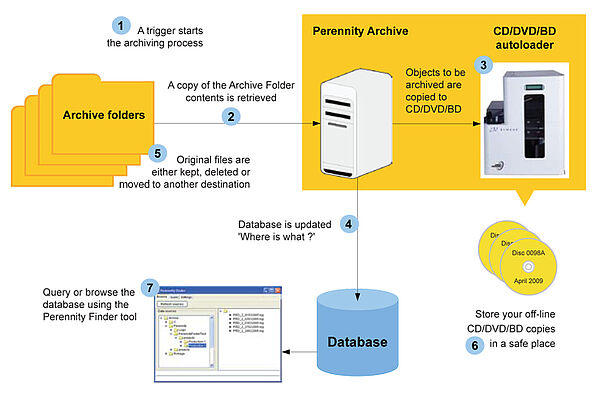In many cases where data is no longer needed for immediate access, offline archiving is becoming increasingly popular. In this sub-discipline of hierarchical storage management, a software tool guards folders or drives and copies the data to optical storage media according to defined rules. The production systems used for offline archiving clearly label the media with a production date, a serial number or any other marking that can be determined. A database records which file in which version is located on which medium and can thus be clearly assigned.
The media used for archiving are characterized by a long shelf life of up to 100 years. This results in a whole series of positive side effects. On the one hand, with the correct storage of the media, there is no longer any need for long-term continuous migration of the data and on the other hand, the data stored in this way does not consume any electricity. Depending on the amount of data to be outsourced, there is an enormous savings potential and thus a very short-term ROI.
The areas of application for offline archiving are as diverse as the systems that generate the data, whether as an offline copy of an existing archiving system in another fire protection zone (mirroring) or as pure data outsourcing.
The systems are used, for example, in hospitals, where videos are recorded for quality control of operations. As a rule, they are never viewed again, but for security reasons they must be stored for up to 30 years. Offline archive systems are also used in quality assurance in the automotive industry. The production logs are simply saved away on the data carriers and stored in a safe in two different fire protection zones and can be removed and reloaded in the rare case of need.
An infinite amount of data also accumulates in research. Although programs like Seti are a rarity, the amount of data increases with more precise measuring methods. The data is not always evaluated immediately, so offline archiving is a cost-effective alternative to storing the data on hard disks.
As a final example, the state surveying offices are grateful customers for the systems. As the resolution of the cameras increases, the resulting flood of aerial photographs and other geoinformation is a cost factor that should not be underestimated. Outsourced to Blu-ray Discs, the data can be further processed as required and thus does not clog up the systems that are working productively.
Offline archiving knows almost no limits due to the flexible application possibilities of media, software and production systems and can be easily tailored to the individual needs of the customer. INCOM offers systems from Epson, Rimage or HIT-Storage with the appropriate software for almost all operating and file systems. As VAD we support resellers from the first consultation to the test installation at the customer.
